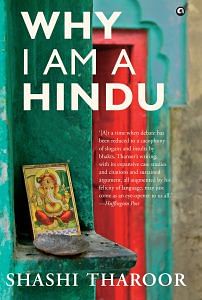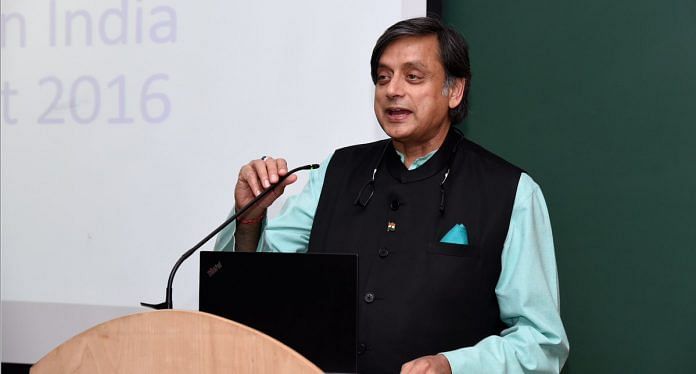In this excerpt from his new book, ‘Why I Am a Hindu’, Congress MP Shashi Tharoor explains nationalism as RSS leader M.S. Golwalkar saw it.
Golwalkar made it clear in his writings that India was the holy land of the Hindus. He writes: ‘Hindusthan is the land of the Hindus and is the terra firma for the Hindu nation alone to flourish upon…’ According to him, India was a pristine Hindu country in ancient times, a place of unparalleled glory destroyed in successive assaults by foreign invaders. He felt that a ‘national regeneration’ was necessary. Throughout his writings, he expresses the view that the national regeneration of this ‘Hindu nation’ (the ‘motherland’ for which the ‘Hindu people’ shed their blood) could only come about through the revival of its Hinduness. Golwalkar rejected the concept of what he called ‘territorial nationalism’ the modern variant of nationalism which identified a state with its territory and bestowed equal rights of citizenship on all those who lived within it. That, to Golwalkar, made no sense: a territory was not a nation, a people constituted a nation. Who were this people? In the Indian case, Hindus. Golwalkar and the RSS became passionate advocates of ‘cultural nationalism’. This, of course, is directly opposed to the civic nationalism enshrined in the Constitution of India.
India’s independence from colonial rule in 1947, Golwalkar argued, did not constitute real freedom because the new leaders held on to the ‘perverted concept of nationalism’ that located all who lived on India’s territory as equal constituents of the nation. ‘The concept of territorial nationalism,’ he wrote, ‘has verily emasculated our nation and what more can we expect of a body deprived of its vital energy? …[and] so it is that we see today the germs of corruption, disintegration and dissipation eating into the vitals of our nation for having given up the natural living nationalism in the pursuit of an unnatural, unscientific and lifeless hybrid concept of territorial nationalism.’
Golwalkar’s Bunch Of Thoughts argues that territorial nationalism is a barbarism, since a nation is ‘not a mere bundle of political and economic rights’ but an embodiment of national culture—in India, ‘ancient and sublime’ Hinduism. In the book, Golwalkar sneers at democracy—which he sees as alien to Hindu culture. He also writes approvingly of Manu as a ‘great soul’; he talks of the high regard in which Manu is held around the world by giving the example of a marble statue in the Philippines with the inscription: ‘The first, the greatest and wisest lawgiver of mankind’. (That Manu’s legal prescription is condemned by many for its elitism and casteism, its gender prejudice, its implicitly authoritarian ethos and its disparagement of the lower castes never crosses Golwalkar’s mind.) But in all fairness, Golwalkar was only echoing Nietzsche, who wrote of the Manu Smriti: ‘This absolutely Aryan testimony, a priestly codex of morality based on the Vedas, of a presentation of caste and of ancient provenance not pessimistic even though priestly—completes my conceptions of religion in the most remarkable manner.’ For Golwalkar, therefore, salvation lies not in Indian democracy, but in the historian Manu S. Pillai’s words, ‘in embracing Hindu dharmocracy’.
Pillai’s phrase is not entirely tongue-in-cheek: Golwakar intends traditional Hindu practices to prevail in his Hindu Rashtra, including caste discrimination. ‘We know as a matter of history,’ he writes, ‘that our north-western and north-eastern areas, where the influence of Buddhism had disrupted the caste system, fell an easy prey to the onslaught of Muslims…. But the areas of Delhi and Uttar Pradesh, which were considered to be very orthodox and rigid in caste restrictions, remained predominantly Hindu even after remaining the very citadels of Muslim power and fanaticism.’ So the more caste-ridden society was, the more robustly it was able to resist the encroachments of the foreign faiths that sought to erode it: to Golwalkar, ‘the so-called “caste-ridden” Hindu Society has remained undying and inconquerable…(while) casteless societies crumbled to dust’.
The alternative to territorial nationalism, to Golwalkar, was a nationalism based on race. In We, or Our Nationhood Defined, at the height of Hitler’s rise, Golwalkar wrote: ‘To keep up the purity of the Race and its culture, Germany shocked the world by her purging the country of the Semitic Races—the Jews. Race pride at its highest has been manifested here. Germany has also shown how well nigh impossible it is for Races and cultures, having differences going to the root, to be assimilated into one united whole, a good lesson for us in Hindustan to learn and profit by.’
This marked an evolution from Savarkar’s notion that saw Hindutva as principally a cultural identity and the Hindu religion as a part of a national Hindu culture. In an important respect, Golwalkar reversed Savarkar’s logic: ‘With us,’ he wrote, ‘culture is but a product of our all-comprehensive religion, a part of its body and not distinguishable from it.’77 From Golwalkar onwards, Hindutva was seen as an ideology seeking to establish the hegemony of Hindus, Hindu values and the Hindu way of life in the political arrangements of India. In this he was building on Savarkar’s derisive rejection of Gandhian ‘universalism’ and ‘non-violence’ which he considered delusionary opiates; instead of Gandhi’s moral lessons in favour of peace, Savarkar advocated the ‘political virility’ of Hindutva, an idea which found full flower in Golwalkar.
Golwalkar made no bones about the principal targets of his race-hatred: ‘Ever since that evil day, when Moslems first landed in Hindustan, right up to the present moment, the Hindu Nation has been gallantly fighting on to shake off the despoilers. The Race Spirit has been awakening’.79 The association of Hindutva with an explicitly anti-Muslim agenda can be traced to its unambiguous avowal by Golwalkar. But ‘race’ fashionable though the term was when Golwakar wrote in the 1930s, especially in the context of Nazi ideology was not a totally accurate word for what he meant, not least since many, indeed most, of India’s Muslims were descended from Hindu ancestors themselves and therefore were of the same race or ethnicity as the Hindus for whom Golwalkar was speaking.
According to the proponents of Hindutva, despite that common descent, Muslims had cut themselves off from Hindu culture: they prayed in Arabic, rather than the Sanskrit born on Indian soil, turned to a foreign city (Mecca) as their holiest of holies, and owed allegiance to a holy book, and beliefs spawned by it, that had no roots in the sacred land of India. Naipaul echoes this thought in his Among the Believers: ‘It turns out now that the Arabs were the most successful imperialists of all time; since to be conquered by them (and then to be like them) is still, in the minds of the faithful, to be saved.’
Golwalkar’s answer was to seek the assimilation of Muslims and other minorities into the Hindu nationalist mainstream by forcing them to abandon these external allegiances (rather as the Jews were forced to adopt outward signs of adherence to Christianity during the Spanish Inquisition four and a half centuries earlier). The German notion of a volksgeist, a ‘race spirit’ to which everyone would have to conform, appealed strongly to Golwalkar. To remain in India, Muslims would have to submit themselves to Hindus. Recalling the parable of Muhammad going to the mountain, Golwalkar wrote: ‘In the Indian situation, the Hindu is the mountain, and the Muslim population, Mohammed. I need not elaborate.’ A few paragraphs earlier I have quoted his approving words about Nazi theories of race. There is more in his writing that is even more chilling.
Golwalkar’s hatred for non-Hindus was especially virulent when it came to Muslims and Christians; he regarded Parsis and Jews in India as model minorities who knew their place and did not ruffle any Hindu feathers. In his pungent view: ‘[H]ere was already a full-fledged ancient nation of the Hindus and the various communities which were living in the country were here either as guests, the Jews and Parsis, or as invaders, the Muslims and Christians.’ He added: ‘They never faced the question how all such heterogenous groups could be called as children of the soil merely because, by an accident, they happened to reside in a common territory under the rule of a common enemy.’
Golwalkar strongly opposed any talk of a secular Indian state. As he wrote in We, or Our Nationhood Defined: ‘There are only two courses open to these foreign elements’, Golwalkar went on, ‘either to merge themselves in the national race and adopt its culture or to live at its mercy so long as the national race may allow them to do so and quit the country at the sweet will of the national race. That is the only sound view on the minorities’ problem… [The] foreign races in Hindusthan must either adopt the Hindu culture and language, must learn to respect and hold in reverence Hindu religion, must entertain no idea but those of the glorification of the Hindu race and culture, i.e., of the Hindu nation and must lose their separate existence to merge in the Hindu race, or may stay in the country, wholly subordinated to the Hindu Nation, claiming nothing, deserving no privileges, far less any preferential treatment—not even citizen’s rights.’
 Shashi Tharoor’s latest book ‘Why I Am A Hindu’ has been published by Aleph Book Company. Excerpted with permission from Aleph.
Shashi Tharoor’s latest book ‘Why I Am A Hindu’ has been published by Aleph Book Company. Excerpted with permission from Aleph.




Who were the invaders? Mughals and British.
Both were destructive for Indians. Indians should think whether they want to be ruled by Islamic extremists or not?
Who were the invaders? Mughlas and British
Both were destructive for India. People should think whether they want to be ruled by Islamic extremists again or not?
Who were the invaders? Mughals and British
Both were destructive for India. Mughlas were Islamic extremists. Already we had unpleasant experience with Mughals. Indians should ensure that we shouldn’t be ruled by Caliphs again. So think wisely
What is economic theory of M S Golwalkar
Instead of gita rss bjp consider golwlkers writing is their vedha
So allegedly prima facie Golwalkar wishes to treat non-Hindus exactly how Koran and Mohammad mandate Muslims treat non-Muslims.
So Golwalkar was inspired by the Koran and Mohammad.
Right? Tharoor the uxoricide.
Dubious and Partisan bunkum peddled by a self-righteous liberal academic who is openly anti-Hindu and anti-Hindutva is now supposed to dispassionately analyze the legacy of Guru Golwalkar and Savarkar ?
Apparently even this absurdity is now ignored in the quest to demonise and defame Hindutva by these pseudo-secularists who have recently “rediscovered” their Hindu origins . Their “notional” Hinduism is no different to the romanticized Anglicized and fetishistic Hinduism that was peddled by Orientalists back in the early 20th century and 19th centuries.